Wine Accessories
Wine Accessories
Antique wine accessories such as Corkscrews, Tasters, Labels, Brandy Pans and Lemon Strainers were often made in silver and are a popular collecting field.
Silver Corkscrews were made for opening wine bottles and also for scent bottles. They are available in many different forms include travelling and novelty shapes.
Wine Tasters. The saucer shaped taster was already in use as early as the 14th century BC in Minoan Crete and has been essential in the production of wine right through to the present time. It is used by the sommelier to determine a wine’s quality by assessing the colour, clarity, bouquet and taste. The majority of wine tasters in existence are French. The owners often engraved their name on the taster whose single flat handle often accommodated a neck cord.
Very few English wine tasters were made because wine was not a national product however a number were produced during the 17th century. These English examples are rare and anything after this date is even rarer. Michael Clayton’s description of wine tasters in his “Silver and Gold in Great Britain and America” states that there are no undoubted wine tasters remaining in England dated earlier than 17th century although they certainly existed much earlier. The standard form is a shallow bowl with a raised centre, generally proud of the rim, against which the colour of the wine may be viewed. Tasters are normally circular about 10.2cm in diameter, however Clayton mentions a rare boat shaped example, hallmarked 1632, with a handle at one end, in a private collection. The placing of the hallmarks on an English wine taster indicates the way in which it is to be held and avoids any confusion with the trencher salt which has a dipped centre. Saucer shaped dishes and small, shallow, two-handed, dishes also existed at this time which could have been tasters but could equally have been sweetmeat dishes or receptacles for mixing sauces at table.
Brandy Saucepans made their first appearance in this country during the Queen Anne period and continued to be made until the mid 19th century. Some have spouts. The size varies but generally the early examples tend to be smaller. Sometimes they have three legs, these are called skillets, and they are quite rare.
Many Brandy Bowls are Dutch in origin. The two-handled bowls were used to celebrate childbirth but may have been passed around at other festive occasions as well when brandewijn, liquor distilled from wine to which sugar and raisins were added, would be served from them with a spoon.
Orange or lemon strainers were peculiar to the 18th century and were probably used in conjunction with punch bowls to filter out the fruit pips. They were made with one or two handles. The one handled strainer sometimes had a small tongue or lug on the opposite side of the handle which may have been used to hook it on to the side of the punch bowl. The strainers are normally marked in the piercing in the centre of the bowl. These strainers are popularly used nowadays as tea strainers although the size is larger than a normal tea strainer.
Wine Labels, also known as “bottle tickets”, appear to have originated in the second quarter of the 18th century. They were made in many attractive designs and are a popular collecting field. Generally, the label is suspended around the neck of the bottle by a chain, although some are formed as plain collars which slip over the neck, or formed as a plain rectangle hinged from a wire ring. Among the many good makers are Hester Bateman and family, Phipps & Robinson, Samuel Bradley, Mary Binley and Paul Storr.
-

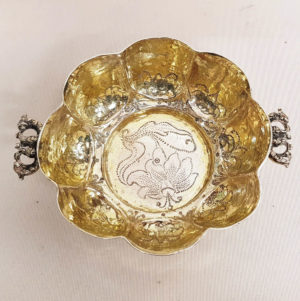
Circa 1600
9453 Antique Nuremberg Silver Wine Taster
Sold
A rare piece of early German silver dating back to circa 1600. A charming little silver taster with scalloped borders and shaped side handles. The centre is engraved with a single flower and leaf motifs picked out with prick dot chasing. The scalloped sides also have prick dot decoration, possibly crown motifs. The interior still has its original gilt finish and the exterior retains traces of the original gilt. Weight 47 grams, 1.5 troy ounces. Width across handles 10.1cm. Height 3.1cm. Top 8.3cm. German silver hallmarks stamped around the edge for Nuremberg circa 1600. Maker Wolff Loschen.
-

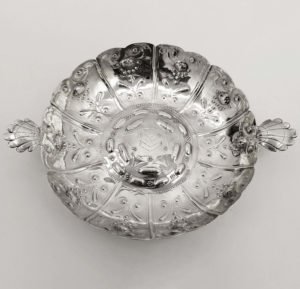
Circa 1631
William Maddox
9605 Antique Charles I Silver Wine Taster
Sold
A rare early 17th century sterling silver dish with applied shell side handles and scalloped rim. Unusual large size. Although quite shallow, this is more probably a wine taster than a sweetmeat dish. The embossed decoration has 10 segments containing flower motifs. The centre has a prick dot circle containing flower heads and a shield shaped cartouche with a simple coat of arms. Weight 217 grams, 6.9 troy ounces. Width across handles 25.6 cm. Diameter 19.2 cm. English silver hallmarks stamped on the edge for London. Circa 1631. Maker William Maddox.
-

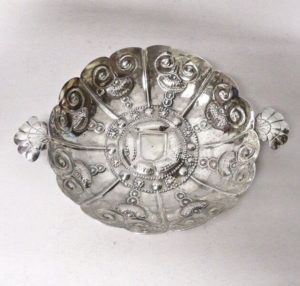
1634
Thomas Maundy
8190 Antique Charles I Silver Wine Taster
Sold
A rare and very beautiful 17th century sterling silver dish with pretty little shell side handles. Although rather shallow, this is more probably a wine taster than a sweetmeat dish. The embossed decoration has 8 segments containing scroll and other motifs. The centre is embossed with concentric prick dot circles containing flowers; inside there are 4 leaves and a shield shaped cartouche with scratched initials “TO” over “EF” to the reverse . Weight 95 grams, 3 troy ounces. Width across handles 18.35 cm. Diameter 11.6 cms. English silver hallmarks stamped around the edge for London 1634. Maker Thomas Maundy* (Jacksons P.119).
-

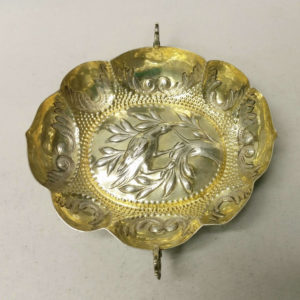
Circa 1650
Hans Jakob Baur
8683 Antique Augsburg Silver Dish
Sold
An early antique German silver dish (or possibly wine taster) of plain oval form with a scalloped border. To the centre there is a charming bird scene surrounded by raised dot decoration. The cast side handles are very pretty. Original interior gilding and a gilt around the top on the outside. Weight 129 grams, 4.1 troy ounces. Height 3 cms (4.5 cms to top of handle). Top of dish measures 16 x 14 cms. Marked on either side of one of the handles with German silver marks for Augsburg and on the inside rim with the makers mark for Hans Jakob Baur. Circa 1650.
-

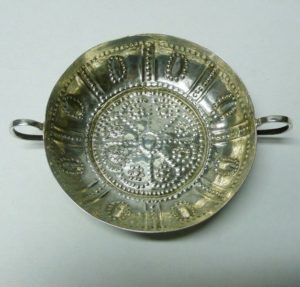
1654
7794 Antique Commonwealth Silver Wine Taster
Sold
A rare early English silver dish of circular shallow form with simple wire handles. The design of punched beading and lobes is typical of the period and forms a flower design in the base of the bowl. Weight 41 grams, 1.3 troy ounces. Height 2 cms. Diameter 8 cms. Spread across handles 10.5 cms. English silver hallmarks stamped around the edge for London 1654. Makers mark IW* (Jacksons P.120).
-

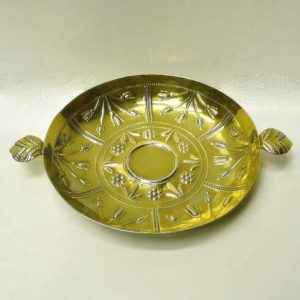
1655
7013 Commonwealth Period Silver Gilt Wine Taster
Sold
A rare and very beautiful 17th century sterling silver dish with original gilt finish. With leaf side handles and decorated with plants and flowers. Although rather shallow, this is probably a wine taster. The centre is engraved with prick dots and initials M over I*R. Weight 186 grams, 6 troy ounces. Width across handles 23 cm. Diameter 17 cms. English silver hallmarks stamped around the edge for London 1655. Makers mark ‘M’ over a star (Jacksons P.121).
-

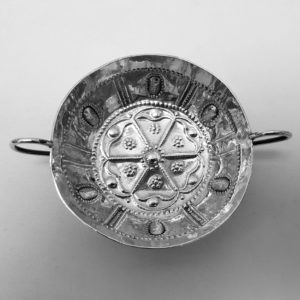
Circa 1655
10189 Commonwealth Period Antique Silver Wine Taster
Sold
A superb early English silver dish of circular shallow form with simple wire handles. Very rare and charming small size. The design of punched beading and lobes is typical of the period and forms a flower design in the base of the bowl. Stamped around the rim with owner’s initials “ALS”. Weight 19 grams, less than one troy ounce. Height 2.2cm (to top of handle). Diameter 6.2cm. Spread across handles 8.5cm. London circa 1655. Maker “WH.” 17th century.
-

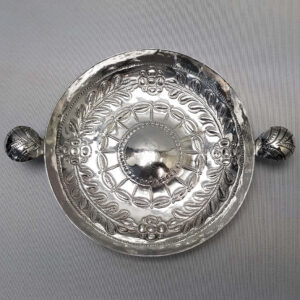
1656
William Harrison
10395 Commonwealth Period Antique Silver Wine Taster
Sold
A rare and very beautiful 17th century silver dish with leaf side handles and hand decorated with bands of flowers, leaves and prick dot engraving. Although rather shallow, this is probably a wine taster as it has the domed centre for viewing the colour of the wine. This could also be called a sweetmeat dish. The centre is engraved with prick dots and initials “S over W*M”. Excellent patina. Weight 128g, 4.1 troy oz. Spread across handles 20.3cm, 8 ins. London 1656. Maker William Harrison. Sterling silver
-

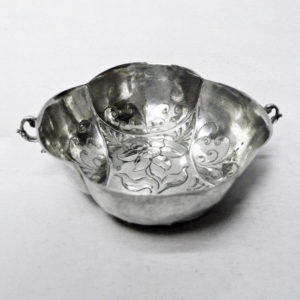
Circa 1660
Reinhold Ruhl
8290 Early Antique Nurnberg Silver Wine Taster
Sold
A rare piece of early German silver. This charming little 17th century silver taster has scalloped borders and shaped side handles. The centre is embossed with a single flower stem surrounded by simple leaf motifs picked out with prick dot chasing. Traces of the original gilt finish, Weight 41 grams, 1.3 troy ounces. Width across handles 11.5 cm. Height 2.7 cms. Top 10.4 x 9.8 cms. German silver hallmarks stamped around the edge for Nurnberg circa 1660. Maker Reinhold Ruhl, noted for his fine quality cups and beakers.
-

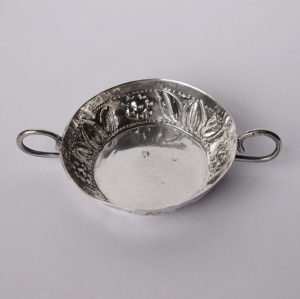
1665
William Goodwin
9117 Antique Charles II Miniature Silver Wine Taster
Sold
A rare early English toy wine taster in sterling silver from the reign of Charles II. Very sweet size. This little cup has a circular form with simple wirework handles and an embossed leaf and flower design. Weight 13 grams. Height 1.5 cm approx. Diameter of top 5 cms. Spread across handles 7.6 cms. London 1665. Makers mark “W.G” (see Jacksons page 123*), possibly William Goodwin free 1654, died 1703 (attribution by Dr David Mitchell “Silversmiths in Elizabethan and Stuart London”).
-

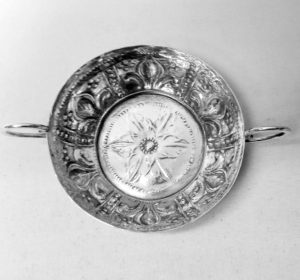
1669
8705 Charles II Silver Wine Taster
Sold
A rare early English silver dish of circular shallow form with two simple side handles. Lovely design with fleur de lys and dots to the lower body and to the centre a large flower within a circle of punched dots. Weight 77 grams, 2.4 troy ounces. Height 3 cms (4 cms to top of handle). Diameter 9.4 cms. Spread across handles 18.5 cms. English silver hallmarks stamped around the edge for London 1669. Makers mark GS (Jacksons P.127 – see photo). Sterling silver.
-

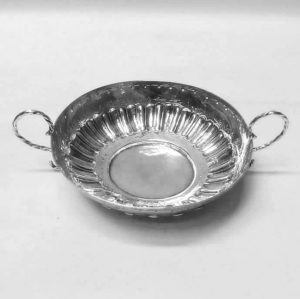
1669
Thomas King
7286 Charles II Silver Wine Taster
Sold
A rare early English silver dish of circular shallow form with two wrythen side handles. Lovely simple design with a half fluted design to the lower body, bands of matting, and prick dot decoration. Weight 143 grams, 4.6 troy ounces. Height 3.5 cms. Diameter 13.5 cms. Spread across handles 18.5 cms. English silver hallmarks stamped around the edge for London 1669. Makers mark TK (Jacksons P.125), probably Thomas King* free 1657, died 1681.
-

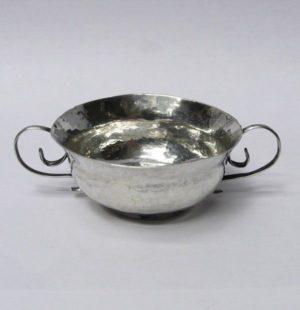
Circa 1670
8131 Charles II Miniature Silver Wine Taster
Sold
A rare early English toy two-handled wine taster in sterling silver from the reign of Charles II. With a simple plain form and wirework handles. This little cup has an excellent patina and hammered finish. Contains 10 ml approx. Weight 12 grams. Height 2 cms. Diameter of top 4.5 cms. Spread across handles 6.7 cms. Marked underneath with the makers mark only “WH conjoined, mullet below”. Mark entered 1670 (see Jacksons page 130*).
-

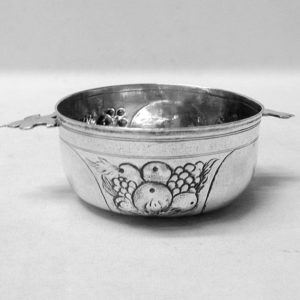
1675
Balthasar Haydt
7799 Antique German Silver Wine Taster
Sold
A 17th century continental silver dish of small size with flat shaped side handles. To the outside there is an embossed decoration of fruit and ribbons. Very charming. Weight 93 grams, 3 troy ounces. Height 4 cms. Diameter 8.5 cms. Spread across handles 13 cms. On the base there is an assay scrape and German silver stamps for Augsburg. Maker Balthasar Haydt. Circa 1675.
-

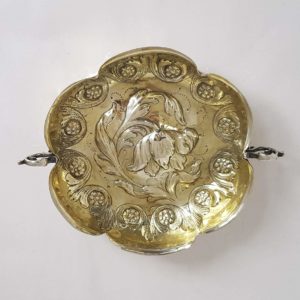
Circa 1680
9734 Antique German Silver Wine Taster
Sold
A charming little 17th century silver dish with scalloped sides and shaped side handles. The centre is embossed with a single flower stem picked out with prick dot engraving. Bold flowers, including poppies and daffodils were very popular during the mid to late 17th century. The gilt finish appears original and there is a gilt band to the outer edge. Owner’s initials “SW” engraved to one side, “EK” to the other. Weight 72 grams, 2.3 troy ounces. Width across handles 16cm. Height 2.8/3.8cm. Diameter 13cm. German silver marks stamped by the handle for maker Paul Hedel Hofer, Breslau. Circa 1680.
-

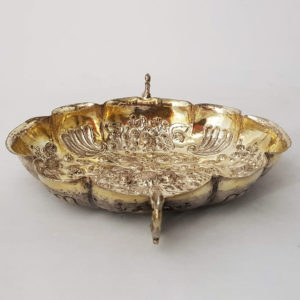
Circa 1680
9876 Antique German Silver Wine Taster
Sold
A charming little 17th century silver dish with scalloped sides and shaped side handles. With a gilt finish inside and to the outside top rim. The centre is embossed throughout with shells, flowers and fruits. Weight 158 grams, 5 troy ounces. Top measures 16.5 x 12.5 cm. Width across handles 16.1 cm. Height 3.1 cm. Continental silver marks stamped by the handle. Probably German. Circa 1680.
-

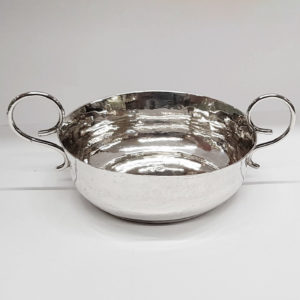
1683
Samuel Hawkes
9523 Charles II Silver Wine Taster
Sold
A rare early English two-handled wine taster in sterling silver from the reign of Charles II. With a simple plain form and wirework handles. Excellent patina and faint signs of the hand hammered finish. Owners initials inscribed underneath. Weight 27 grams, just under 1 troy ounce. Height 2.2 cm (bowl), 3.5 cm (to top of handle). Diameter of top 6.5 cm. Spread across handles 9.2 cm. London 1683. Maker’s mark “SH” within a heart shaped shield, probably Samuel Hawkes (*see David Mitchell’s book on “Silversmiths in Stuart and Elizabethan England”).
-

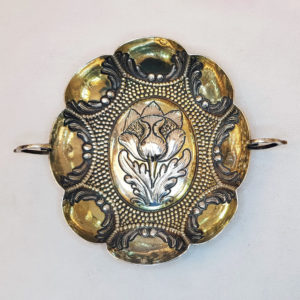
Circa 1690
Heinrich Eichler
10107 Antique German Silver Wine Taster
Sold
A pretty little 17th century silver dish of oval form with scalloped sides and shaped side handles. Gilt finish to the interior and outside top rim. The centre, with the flower decoration typical of the period and embossed star design, retains a silver finish. Weight 76 grams, 2.4 troy ounces. Top measures 11.1 x 9.9cm. Width across handles 13.2cm. Height 2.2cm, 3.1cm to top of handle. Augsburg, Germany. Maker Heinrich Eichler. Circa 1690.
-

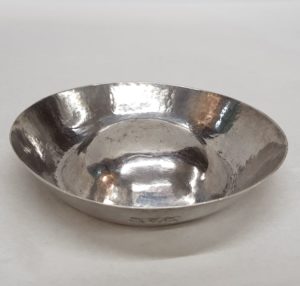
1697
William Denny And John Backe
9341 Antique Silver Wine Taster
Sold
A rare early antique silver wine taster of simple plain form in the shape of a flat bowl with a raised central dome. Very charming with the original hand beaten silver. At a later date the reverse side has been gilded for use as a trencher salt and the crest of an otter hand engraved to the front. Weight 86 grams, 2.7 troy ounces. Height 2.1 cm. Diameter 11.7 cm. Stamped on the side for London 1697. Maker possibly William Denny and John Backe – see Jacksons page 150.
-

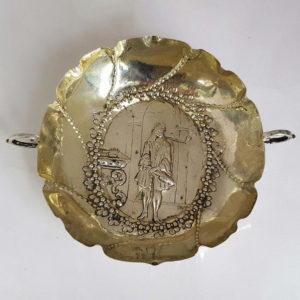
1700
9712 Antique German Silver Dish
Sold
An interesting piece of early German silver with a tobacco smoking scene to the centre. Original gilt interior. The little dish, or wine taster, has scalloped borders and scrolled side handles. Embossed to the centre is the figure of a man in 17th century clothing and smoking a giant pipe; a brazier stands on the table to the left. The cartouche is formed from embossed dots and foliage in typical 17thcentury style. Weight 95 grams, 3 troy ounces. Width across handles 13.15cm. Height 3.1cm. Top 12.8cm. German silver hallmarks stamped around the edge for Augsburg circa 1700. Maker probably “IK” unidentified.
-

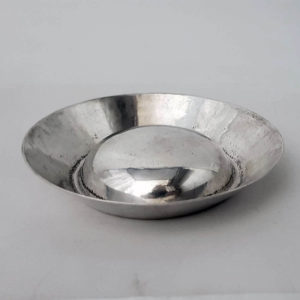
Circa 1700
9895 Antique Silver Wine Taster
Sold
A rare early antique silver wine taster of simple plain form in the shape of a flat bowl with a raised central dome. Very charming with the original hand beaten silver. At a later date the reverse side has been gilded for use as a trencher salt and the crest of a beaver holding a fish hand engraved to the front. Weight 78 grams, 2.5 troy ounces approx. Height 2.1cm. Diameter 11.47cm. Unmarked silver. Circa 1700. Probably English.
-

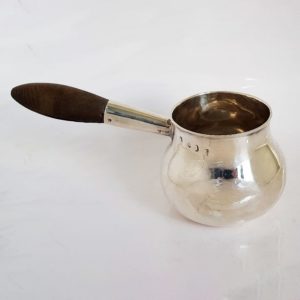
1709
Joseph Sheene
8409 Queen Anne Silver Brandy Saucepan
Sold
A rare early English silver brandy pan with wooden side handle. Britannia standard silver. Brandy saucepans first made an appearance during the reign of Queen Anne so this is a very early example. Good size and lovely hammered finish with good patina. Weight 332 grams, 10.6 troy ounces. Height 10 cms. Spread 22.5 cms. Diameter 9 cms (top), 11 cms (max). London 1709. Maker Joseph Sheene.
-

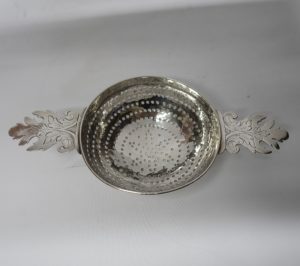
Circa 1710
John Chartier
9020 Queen Anne Antique Silver Lemon Strainer
Sold
A rare early English antique silver strainer of circular form with a turned over rim. *Britannia standard silver. The bowl has drilled pierced holes with a five-pointed star to the centre. The acanthus shaped handles have hand decoration. Weight 68 grams, 2.1 troy oz. Spread 18.5 cm, 7.5 inches. Marked to the reverse of handles with the Britannia standard mark for John Chartier and second makers mark, F R or IB in a shaped cartouche with two pellets above. London circa 1710-15.
-

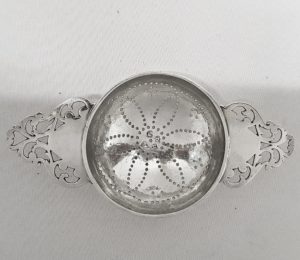
1717
Robert Kempton
9438 Antique George I Silver Lemon Strainer
Sold
A rare early English antique sterling silver strainer of circular form with a turned over rim. The bowl has drilled pierced holes in a flower shape and long shaped handles with pierced decoration. Weight 79 grams, 2.5 troy oz. Spread 16.6cm. Diameter 8.5cms. Height 3cm. London 1717. Maker Robert Kempton.
-

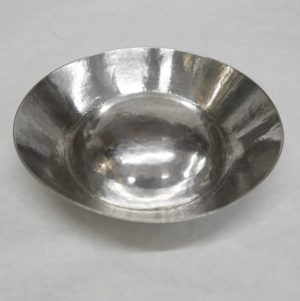
1720
John Bache
9301 George III Antique Silver Wine Taster
Sold
A rare early antique silver wine taster of simple plain form in the shape of a flat bowl with a raised central dome. Very charming with the original hand beaten silver. At a later date the reverse side has been gilded for use as a trencher salt and the crest of an otter hand engraved to the front. Weight 98 grams, 3.1 troy ounces. Height 2 cm. Diameter 11.3 cm. Stamped on the side for London 1720. Maker John Bache.
-

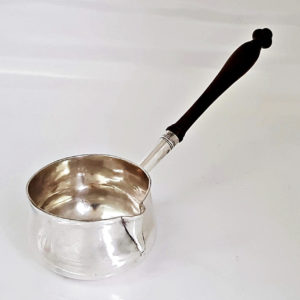
Circa 1720
John Murch
9749 Antique Exeter Silver Brandy Pan
Sold
A rare piece of early provincial silver. An antique silver brandy warmer of bellied form with a turned wooden handle. Attractive plain style. Contains 240 ml. Total weight 153 grams, 4.9 troy ounces. Height of pan 6cm. Diameter of top 8.5cm. Spread 26cm. Exeter circa 1720. Maker John Murch.
Literature. Brandy Saucepans made their first appearance in this country during the Queen Anne period and continued to be made until the mid 19th century. Some have spouts. The size varies but generally the early examples tend to be smaller. Sometimes they have three legs, these are called skillets, and they are quite rare.
-

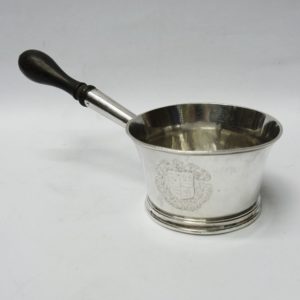
1721
Samuel Wastell
9124 George I Silver Brandy Pan
Sold
A rare antique early antique sterling silver brandy pan with turned wooden handle and straight tapering sides. Excellent plain style. Good patina. Hand engraved to the front with an armorial within a decorative cartouche. Weight 176 grams, 5.6 troy ounces. Height of pan 5.6 cms, 9.2 cms to top of handle. Diameter of top 9.5 cms. Spread 22 cms. London 1721. Maker Samuel Wastell.
-

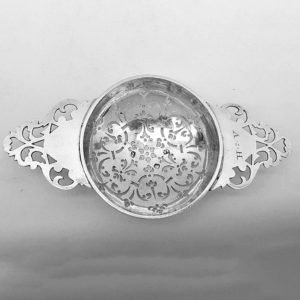
1722
John Albright
9942 George I Antique Silver Strainer
Sold
A rare early English antique sterling silver strainer of circular form with decorative side handles. A very charming and useful size; although originally made as a lemon strainer this could be used nowadays as a tea strainer. The bowl is pierced with a design of scrolls and other motifs and contemporary owner’s initials are engraved to one handle. Weight 75 grams, 2.4 troy oz. Spread 16.8cm. Diameter 8.5cm. Height 2.9cm. London 1722. Maker John Albright. Sterling silver
-

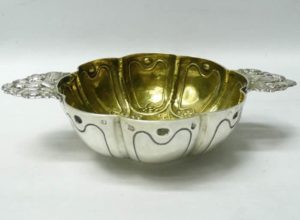
Circa 1729
Andries Roda
7689 Antique Dutch Silver Brandy Bowl
Sold
An early Dutch silver bowl with lobed decoration and cast handles showing a child holding a basket of fruit. Gilt interior. Assay scrape below both handles. Weight 152 grams, 4.8 troy ounces. Height 5 cms. Spread 21.25. cms Diameter 13.5 cms. Marked around the edge of the bowl with Dutch silver marks for Haarlem 1721. Makers mark (a flower) for Andries Roda 1676-1729.
-

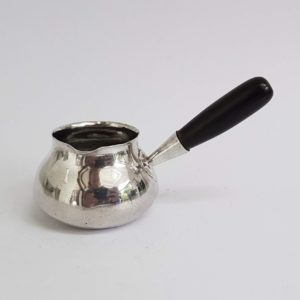
Circa 1730
10115 George II Antique Silver Miniature Brandy Pan
Sold
A charming little antique silver toy saucepan of circular bellied form with a pouring lip and ebonised wooden handle. The pot looks like an exact copy of a full size original. Owner’s initials engraved underneath. Weight 14 grams, 0.5 troy ounce. Height 3cm. Spread 7cm. Diameter at the top 5.5cm. Maker’s mark “duck”. English. Circa 1730.
-

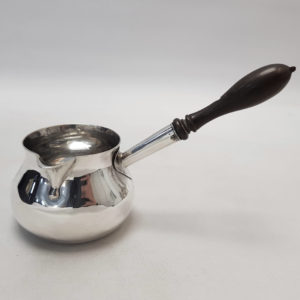
1732
John Gamon
10223 George II Antique Silver Brandy Pan
Sold
A delightful piece of early English silver. An antique silver brandy warmer of bellied form with an elegant turned wooden handle. Small size and attractive plain style. Contains 100 ml. Total weight 83 grams, 2.6 troy ounces. Height of pan 5/10cm. Spread 14.5cm. London 1732. Maker John Gamon. Sterling silver.
-

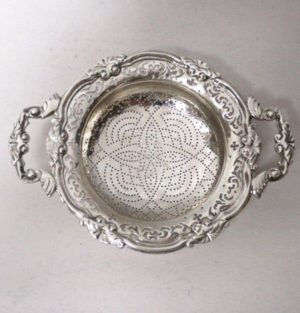
1742
Paul de Lamerie
8189 George II Silver Orange Strainer by Paul de Lamerie
Sold
A superb antique silver orange or lemon strainer by the sought after Huguenot silversmith Paul de Lamerie. With a pretty applied border, pierced edge and two cast handles; the centre has a decorative pattern of fine holes. This little silver strainer is a very charming example of Lamerie’s work. Weight 126 grams, 4 troy ounces. Height 2.25 cms. Spread across handles 15.5 cms. Diameter 11.6 cms. London 1742. Maker Paul de Lamerie.